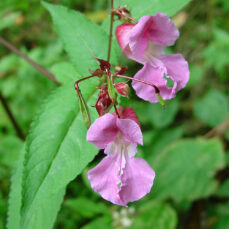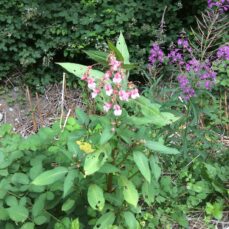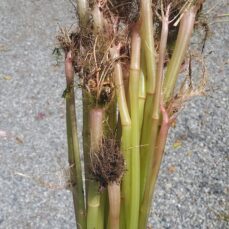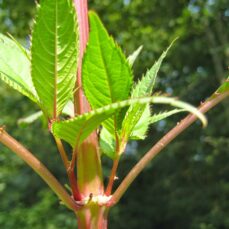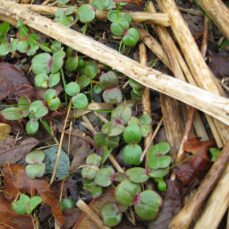.
Management Strategy
Squamish
Whistler
Pemberton
Vectors of Spread
Synonyms
- Policeman’s helmet
- Poor man’s orchid
- Indian balsam
- Ornamental jewelweed
ID Characteristics
General: Himalayan balsam is an exotic-looking annual.
Flowers: Himalayan balsam flowers can be a wide range of colours, including pink, purple, white or even reddish. They resemble an old-fashioned policeman’s helmet. They have 5 petals and are bilaterally symmetrical (2.5 – 4 cm long).
Stems: Are hollow and branched, with a reddish-purple hue. Stems are thick, hairless and easily broken. Himalayan balsam can grow up to 3 m tall.
Leaves: Himalayan balsam leaves have pointed tips and rounded bases, with finely saw-toothed, serrated edges. They decrease in size the higher up on the stem they grow. They are dark green with a metallic sheen and sometimes red margins. Leaves grow in opposite pairs along the stem, or whorls of three.
Seeds: Seed pods are 1.5 – 3.5 cm long and up to 1.5 cm wide, containing up to 16 seeds each. Once the seed pods dry, they split open and eject the seeds up to 6 m away!
Roots: Roots are red-pink and minimal. They only extend 10 – 15 centimetres into the soil.
Similar Species
Invasive:
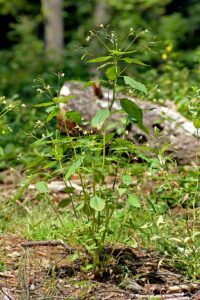
By André Karwath aka Aka – Own work, CC BY-SA 2.5, https://commons.wikimedia.org/w/index.php?curid=239832
Smallflower touch-me-not(Impatiens parviflora), which has yellow-orange flowers, more rounded leaf blades, and is much smaller.
Native:

Orange Jewelweed
Orange jewelweed (Impatiens capensis) is native to North America and has yellow to orange flowers. It also has more rounded leaf blades with fewer serrations and an alternate leaf arrangement.
Habitat and Origin
Himalayan balsam originates from the Western Himalayas and was introduced to Canada in the early 1900s as a garden ornamental. It is now considered invasive in many countries worldwide.
Himalayan balsam loves moist, shaded environments, and is usually found along river banks and wetlands. It grows best in the nutrient-rich soils of disturbed riparian habitats and damp woodlands and is tolerant of partial shade and a wide range of soil acidities.
How it Spreads
Himalayan balsam is an annual plant that reproduces exclusively by seed, travelling to new sites through water flow and human activity. The seeds germinate and form new plants following a cold snap.
Himalayan balsam seed pods explode at maturity and release up to 2,500 seeds per plant. In dense infestations, this can spread up to 32,000 seeds per square meter. The seeds can be transported by water flow; mowing the plant after the seeds have formed can also help this plant spread. Lastly, Himalayan balsam is sometimes sold and collected as an ornamental garden plant.
Impacts
Ecological:
- Forms dense monocultures and displaces native vegetation.
- Due to its shallow root system and annual life cycle, Himalayan balsam leaves soils barren and exposed to the elements in the wintertime, increasing the risk of erosion.
Economic:
- Clogs drainage ditches, damaging infrastructure and leading to costly repairs.
Stop the Spread
Himalayan balsam is abundant in certain portions of the Sea to Sky region (i.e., Squamish and south), but it has not yet infested all potential habitats. The goal is to contain the spread of Himalayan balsam to ISMA 1.
Learn to identify Himalayan balsam: use the images presented on this profile page to learn how to identify Himalayan balsam.
What to do if you spot it: You can report any Himalayan balsam sightings by visiting our reporting page.
DO:
- Regularly monitor properties for weed infestations.
- Ensure soil and gravel are uncontaminated before transport.
- Check wildflower mixes to ensure that they do not contain Himalayan balsam.
- Ensure that plants are disposed of in a garbage bag if found in floral arrangements to prevent seeds from spreading.
DO NOT:
- Unload, park or store equipment or vehicles in infested areas; remove plant material from any equipment, vehicles or clothing used in such areas and wash equipment and vehicles at designated cleaning sites before leaving infested areas.
- Plant Himalayan balsam in a garden, no matter how well-contained its enclosure may seem.
- Move soil that has been contaminated with Himalayan Balsam.
- Compost Himalayan balsam!
Control
Mechanical Control
Hand-pulling Himalayan balsam is a relatively easy and effective control method. When the soil is moist, the shallow roots are more likely to be fully removed. However, due to its prolific seed production, missing just one flowering plant can set management efforts back. Removing 99% of the plants in an area is almost as ineffective as no management at all, so diligence in removing this species is essential.
Seeds remain viable in the soil for up to 18 months, so it is possible to control an infestation with a handful of manual removals, as long as each one is thorough. Avoid pulling this weed close to a stream bank as it can increase erosion and even alter the water course.
Chemical Control
Glyphosate, 2,4-D and triclopyr have proven effective on Himalayan balsam, but their use on sites adjacent to water courses or riparian areas is restricted in BC, which makes chemical control next to impossible.
We recommend that any herbicide application is carried out by a person holding a valid BC Pesticide Applicator Certificate. Before selecting and applying herbicides, you must review and follow herbicide labels and application rates; municipal, regional, provincial and federal laws and regulations; species-specific treatment recommendations, and site-specific goals and objectives.
Biological Control
No biocontrol agents are currently available for Himalayan balsam in B.C., though various options are being explored through ongoing government research.
Sea to Sky Distribution
Himalayan Balsam Factsheet
Additional Resources
- Alberta Invasive Species Council, Himalayan Balsam
- Alberta Invasive Species Council, Himalayan Balsam Factsheet
- Electronic Atlas of the Flora of BC, Impatiens glandulifera
- Fraser Valley Invasive Species Society, Himalayan Balsam
- Government of Alberta, Quick Facts: Himalayan Balsam
- Invasive Species Centre, Himalayan Balsam (Impatiens glandulifera)
- Invasive Species Compendium, Impatiens glandulifera
- Invasive Species Council of BC, Himalayan Balsam (Policeman’s Helmet)
- Invasive Species Council of BC, Himalayan Balsam TIPS Factsheet
- Metro Vancouver, Best Management Practices for Himalayan Balsam in the Metro Vancouver Region
- Metro Vancouver, Tackling Himalayan Balsam





